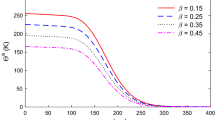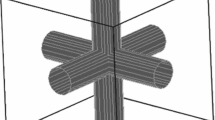Abstract
The non-linear quasi-static and dynamic elastic behaviour of Berea sandstone has been experimentally analysed showing hysteresis and a strong influence of moisture especially in the lower saturation range. It is shown that non-linear hysteretic response originates within the “bond system” of the material, that includes microcracks, intergrain contacts, asperities, dislocations, ... Hysteresis or non-classical non-linear behaviour is explained by the fact that the defects do not open and close at the same pressure. In dynamic loading a small number of these defects are activated explaining the higher stiffness compared to quasi-static loading, where a lot of defects are closed or opened. These effects can be adequately described in the framework of the so-called P-M (Preisach-Mayergoyz) space model.
In the framework of poromechanics we show that the moisture influence on the non-linear elastic behaviour cannot be described by the effective stress concept. Two coupling coefficients (a classical and non-classical) are introduced to describe the fluid-solid coupling. These coupling coefficients are found not to be uniquely proportional to the degree of saturation (or volumetric water filling of the pore structure). The analysis of the experimental data show that, in the fine pore range situated in the bond system (clay, silica glue) where high fluid-solid interaction forces take place, the coupling coefficient increases proportional with fluid saturation. However, in an intermediate pore range the coupling coefficients decrease indicating less solid-fluid interaction in the coarse pore structure.
Résumé
L'analyse experimentale du comportement élastique non-linéaire quasi-statique et dynamique de la pierre calcaire Berea démontre une hystérèse et une forte influence de la teneur en humidité, spécialement à basse saturation. Il est démontré que la réponse hystérétique non-linéaire provient du “système liant” du matériau, ce qui inclus les micro-fissures, les contacts intergrain, les aspérités, les dislocations, etc. L'hystérèse, ou comportement non-linéaire non-classique, s'explique par le fait que les défauts ne s'ouvrent ou se ferment pas tous à la même pression. En chargement dynamique, un faible nombre de ces défauts est activé, ce qui explique une rigidité supérieure à celle obtenue en chargement quasi-statique, où une grande proportion de défauts s'ouvrent ou se ferment. Ces effets sont adéquatement décrits par le truchement du soi-disant modèle d'espace P-M (Preisach-Mayergoyz).
D'un point de vue poromécanique, il est démontré que l'influence de la teneur en humidité sur le comportement élastique non-linéaire ne peut être décrite par le concept de contrainte effective. Deux coefficients de couplage (un classique et un non-classique) sont introduits pour décrire le couplage liquide-solide. Ces coefficients de couplage ne varient pas seulement proportionnellement au degré de saturation (volume d'eau dans la structure poreuse). L'analyse des données expérimentales démontre que, pour les plus petits pores du système liant (argile, colle de silice) où de fortes interactions liquide-solide ont lieu, la valeur du coefficient de couplage augmente proportionnellement avec la saturation liquide. Cependant, pour les pores de grosseur intermédiaire, la valeur des coefficients de couplage diminue, indiquant qu'il y a moins d'interactions solide-liquide dans une structure plus grossière.
Similar content being viewed by others
References
Bažant, Z.P., ‘Constitutive equation for concrete creep and shrinkage based on thermodynamics of multi-phase systems’,Mater. Struct. 3 (1970) 3–36.
Bažant, Z.P., Hauggaard, A.B., Baweja, S. and Ulm, F.-J., ‘Microprestress-solidification theory for concrete creep. I: Aging and Drying effects’,Journal of Engineering Mechanics, ASCE 123 (1997) 1188–1194.
Bear, J. and Bachmat, Y., ‘Introduction to Modeling of Transport Phenomena in Porous Media’ (Kluwer Academic Publishers, Dordrecht, 1991).
Carmeliet, J., ‘Coupling of damage and fluid-solid interactions in quasi-brittle nonsaturated porous materials’, Proceedings of the Iutam symposium on Theoretical and Numerical Methods in Continuum Mechanics of Porous Materials, W. Ehlers ed. (Kluwer Academic Publishers, Dordrecht, 1999) 307–312.
Carmeliet, J. and Van Den Abeele, K.E.A., ‘Application of the Preisach-Mayergoyz space model to analyze moisture effects on the nonlinear elastic response of rock’,Geophysical Research Letters 29 (7) (2002).
Carmeliet, J. and Roels, S., ‘Determination of the moisture capacity of porous building materials’,Journal of Thermal Envelope and Building Science 25(3) (2002) 209–237.
Carmeliet, J., Houvenaghel, G. and Descamps, F., ‘Multiscale network for simulating liquid water and water vapour transfer properties of porous materials’,Transport in Porous Materials 35 (1999) 67–88.
Coussy, O., ‘Mechanics of Porous Continua’ (John Wiley & sons, Chichester, 1995).
Coussy, O., Eymard, R. and Lassabatère, T., ‘Constitutive modelling of partially saturated materials with phase change. Application to the drying shrinkage of concrete’,Journal of Engineering Mechancis, ASCE 124 (1998) 658–667.
Guyer, R.A., McCall, K.R. and Boitnott, G.N., ‘Hysteresis, discrete memory and nonlinear wave propagation in rock’,Phys. Rev. Let. 74 (1994) 3491–3494.
Guyer, R.A., McCall, K.R., Johnson, P.A., Rasolofosaon, P.N.J. and Zinszner, B., ‘Equation of state hysteresis and resonant bar measurements on rock’, International Symposium on Rock Mechanics, J.J.K. Daemon and R.A. Schultz, Eds., Balkema, Rotterdam (1995) 177–181.
Guyer, R.A., McCall, K.R., Boitnott, G.N., Hilbert Jr., L.B. and Plona, T.J., ‘Quantitative implementation of Preisach-Mayergoyz space to find static and dynamic elastic moduli in rock’,J. Geophys. Res. 102 (1997) 5281–5293.
Guyer, R.A. and Johnson, P.A., ‘Nonlinear mesoscopic elasticity: Evidence of a new class of materials’,Physics Today 52 (1999) 30–35.
Israelachvili, J.N., ‘Intermolecular and Surface Forces with Application to Colloidal and Biological Systems (Academic Press, London, 1985).
Landau, L.D. and Lifshitz, E.M., ‘Theory of Elasticity’, 3rd ed. (Pergamon, Oxford, 1986).
McCall, K.R. and Guyer, R.A., ‘Equation of state and wave propagation in hysteretic nonlinear elastic material’,J. Geophys. Res. 99 (1994) 23887–23897.
Mayergoyz, J.D., ‘Hysteresis models from the mathematical and control theory points of view’,J. Appl. Phys. 57 (1985) 3803.
Powers, T.C., ‘Mechanism of shrinkage and reversible creep of hardened cement paste’, Proc. Int. Conf. on the Struct. of Concrete. Cement and Concrete Association, London, U.K. (1965) 319–344.
Preisach, F., ‘On the magnetic action (Über die magnetische Nachwirkung)’,Z. Phys. 94 (1935) 277 [in German].
Tokunaga, T., Hart, J.H. and Wang, H.F., ‘Complete set of anisotropic poroelastic moduli for Berea sandstone’, Proc. Biot Conf. on Poromechanics, J.-F. Thimuset al. eds. (Balkema, Rotterdam, 1998) 629–634.
Van Den Abeele, K.E.A., Carmeliet, J., Johnson, P.A. and Zinszner, B., ‘Influence of water saturation on the nonlinear elastic mesoscopic response in earth materials and the implications to the mechanism of nonlinearity’,Journal of Geophysical Research-Solid Earth 107 (6) (2002).
Wittmann, F.H., ‘Identification of the physical properties of cement stone (Bestimmung physikalischer Eigenschaften des Zemmentsteins)’,Demscher Ausschuss für Stahlbeton, Heft 232 (W. Ernst & Sohn, Berlin, 1974) 1–63 [in German].
Yates, D.J.C., ‘The expansion of porous glass on the adsorption of non-polar gases’, Proc. Royal Soc. London A224, (1954) 526–543.
Zinszner, B., Johnson, P.A. and Rasolofosaon, P.N.J., ‘Influence of change in physical state on elastic nonlinear response in rock: effects of confining pressure and saturation’,J. Geophys. Res. 102 (1997) 8105–8120.
Author information
Authors and Affiliations
Rights and permissions
About this article
Cite this article
Carmeliet, J., Van Den Abeele, K. Poromechanical approach describing the moisture influence on the non-linear quasi-static and dynamic behaviour of porous building materials. Mat. Struct. 37, 271–280 (2004). https://doi.org/10.1007/BF02480635
Received:
Accepted:
Issue Date:
DOI: https://doi.org/10.1007/BF02480635




